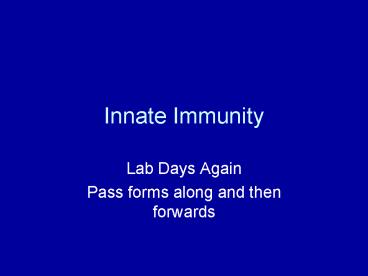Innate Immunity - PowerPoint PPT Presentation
1 / 37
Title:
Innate Immunity
Description:
Lack of nutritional requirements. Lack of target site for toxins ... Microbial products stabilise C3 convertase. Build up of C3b acts as opsonin. Tight regulation ... – PowerPoint PPT presentation
Number of Views:33
Avg rating:3.0/5.0
Title: Innate Immunity
1
Innate Immunity
- Lab Days Again
- Pass forms along and then forwards
2
Innate Immunity lecture 4/5
- Innate immune system refers to defence systems
permanently in place. - Only when these are overcome does adaptive immune
response kick in. - The adaptive response, while slow to respond on
first exposure to a foreign antigen, has the
characteristic of memory, such that on subsequent
exposure a rapid response ensues.
3
(No Transcript)
4
Innate defences
- 1Differences in susceptibility to certain
pathogens - 2Anatomical defences
- 3 Microbial antagonism
- 4 Tissue bactericides, including complement,
acute phase proteins and lysozyme - 5 Inflammation (ability to undergo an
inflammatory response) - 6 Phagocytosis
5
Differences in Susceptibility
- Absence of tissue/cell receptors for attachment
- Temperature of host
- Lack of nutritional requirements
- Lack of target site for toxins
6
Individual resistance in same species
- Age
- Sex
- Stress
- Diet, malnutrition
- Inter-current disease or trauma
- Therapy against other diseases
7
Physical Barriers
- Skin
- Mucous Membranes
- Respiratory tract
- Mouth, stomach and intestinal tract
- Uro-genital tract
- Eyes (conjunctiva)
8
Microbial antagonism
- Competition with non-indigenous species
- Specific antagonism - bacteriocins
- Non-specific antagonism - metabolites
- Mimsp47-48
9
Tissue bactericides and complement
- Lysozyme
- Complement
- Basic proteins/peptides
- Lactoferrin/transferrin
- Peroxidase
- Fibronectin
- Interferons
- Interleukins
10
Complement
- Innate and inducible defence
- Triggered cascade enzyme system
- Central role played by C3 convertase
11
Alternative pathway
- Normal plasma- C3 spontaneous activation to
release C3b - C3b BgtgtgtgtgtgtC3bBb
- C3bBb normally broken down rapidly
- In the presence of bacterial surfaces C3bBb
stabilised - Positive feedback loop
12
Complement
- Microbial products stabilise C3 convertase
- Build up of C3b acts as opsonin
- Tight regulation
13
(No Transcript)
14
Complement synergises with phagocytesgtinflammmator
y response
- C3b and C3 convertase act on C5
- C5a and C3a triger
- Vascular permeabilisationAllows exudation of
fluid and plasma components - Chemotactic factorsAttract leukocytes
(granulocytes/neutrophils) - Mast cell degranulation
- Arachidonic acid pathway
15
Acute inflammatory response
- Capillary dilation- erythema
- Exudation of plasma proteins and fluid-edema
- Accumulation of neutrophils
- Focuses phagocytes on opsonised invader
16
(No Transcript)
17
(No Transcript)
18
Mast cell mediators
- HistamineVasodilation, capillary permeability,
bronchoconstriction - HeparinAnticoagulant
- ChemokinesAttract phagocytes including
polymorphs and monocyte/macropahges
19
Destruction of invader
- Opsonisation leads to uptake by phagocyteor
- Destruction by membrane attack complex
20
(No Transcript)
21
(No Transcript)
22
Membrane attack
- C5b membrane bound
- Binds C6,7,8
- This complex allows C9 partial unfolding and
insertion in membrane to make an - Annular channel
- Influx of Na leads to lysis
23
(No Transcript)
24
(No Transcript)
25
E-M of MAC in Shigella dysentariae
26
Summary of complement functions
- Generation of inflammatory factors
- Attraction of phagocytes
- Enhancement of phagocytosis
- Lysis of bacterial or virus infected cells
- Read about in Mims 53-57
27
Professional phagocytes
- Macrophages and polymorphonuclear phagocytes
(neutrophils/granulocytes) - Distribution
28
(No Transcript)
29
Types of mononuclear phagocytes
30
Phagocytes
- Macrophages long lived
- Neutrophils short lived - no mitochondria -
- Contain granules with powerful enzymes
- Primary-myeloperoxidase, lysozyme,cationic
proteins - Secondary-lactoferrin and lysozyme
- Tertiary-acid hydrolases
31
Phagocytes
- Monocytes 3-7 of circulating white blood cells
- actively phagocytic and bactericidal - Migrate into tissues and differentiate to
macrophages -inflammatory stimuli
32
Phagocytosis
- Delivery of phagocyte to site of infection
- Adherence-lectin like receptors or complement
- Ingestion-pseudopodial extensions
- Phagolysosome- fusion with endosomes
- Intracellular killing-enzymes,pH, O2,NO
- Intracellular digestion
33
(No Transcript)
34
http//ntri.tamuk.edu/immunology/mac.mov
35
Acute phase response
- Acute phase proteins.
- When macrophages are triggered into inflammatory
state by opsonised microbes, C5a, and toxins,
they release pro-inflammatory cytokines IL-1,
IL-6 and TNF. - These trigger the release of acute phase
proteins, such as C-reactive protein which
assists complement fixation. - Fever/pyrexia
36
Interferons and NK cells
- Interferons
- Involved in antiviral response, by triggering
synthesis of protective enzymes such as polyA
synthase. - NK Cells
- Primarily involved in destroying viral infected
cells. Triggered by glycoproteins on viral
infected cells, and kill via perforin and
granzyme B.
37
Reading for innate immunity
- Mims, Chapter 4
- P47-62



















![Immunity [M.Tevfik DORAK] PowerPoint PPT Presentation](https://s3.amazonaws.com/images.powershow.com/P1254413703joFem.th0.jpg?_=20210623114)











